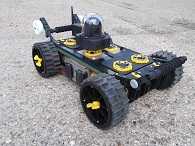
Posted to News on 16th Jul 2016, 17:16
World's first modular robot system uses maxon motor
When architectural designer Philip started to develop a superior construction toy for his children it unpredictably resulted in the world's first modular multi-functional robot system.

One robot for one task is traditional, but what happens when you are working in an environment that demands multiple tasks? Instead of enduring multiple different robots, dealing with multiple different companies, using multiple different interfaces, with multiple different support teams and multiple different contracts, Philip designed one robot, an intelligent mobile machine, that can be modularly configured to do multiple tasks.
Philip's company, Ross Robotics, specialises in building unmanned ground vehicles (UGVs) that replace people where they shouldn't or can't work. Unmanned robots are well suited for dull, dirty and dangerous tasks. They are deployed in settings such as:
- Inspection and survey of pipes and sewers
- Emergency relief services
- Oil & gas platforms
- Nuclear research & decommissioning
- Security & policing
- Mining
- Bomb disposal
Philip first contacted maxon in 2010. Philip says: "We were looking for a DC motor that was easy to drive at a low speed, had a high torque and importantly was of a certain size because of the small space envelope we had. maxon's standard EC 45, 70 watt, flat BLDC motors are ideal. We enjoy working with maxon, they are always happy to help."
maxon's flat brushless DC motors are especially suitable for installation in confined spaces. The brushless motors are designed with a multi-pole rotor for high torque to weight ratio.
The company prides itself on producing easy-to-use unmanned vehicles that customers can devise themselves depending on their requirement. Useability is key. Instead of the usual two-dimensional modularity, the design has three dimensional modularity. This means each part connects with many other parts in many ways.
Some of the distinctive features are:
- The modules can be effortlessly swapped out, enabling the robot to perform many different functions. The sockets have power and data.
- In the event of a technical failure, fresh modules can be substituted instantly to keep equipment running 24/7.
- The tyres are easily changed for different terrains. It is even possible to drive vertically with a payload.
- The machines are built in plastic and metalised or demetalised as required. The plastic parts are specifically designed so they do not wear when metalised.
- They are tool free, super lightweight and easy to carry.
- The robots are intelligent, with an application program interface (API) that reconfigures itself based on the connecting modules.
- The connectors have axial repositioning and can connect orthogonally.
- The robots run on lithium batteries so if a robot needs to travel a long way, the base deck is just made larger and more batteries are added.
- The base deck is a standard panel made from carbon fibre composite.
- The driving performance is very accurate and can go from a crawl to a sprint.
The robots are very resilient and designed to perform in unstructured environments, to avoid obstacles, to react to unpredictable events and cope with vibration, dust and radiation. It is these characteristics that have brought the company to the attention of CERN, the European Organisation for Nuclear Research, the EDEN project at Chernobyl, the security forces, first responders and the emergency services.
Ross Robotics has a collaborative parternship with CERN. CERN has over 50km of tunnels and the mobile machine is used for inspection. It has to be non-magnetic as the radiation reaches 4 Tesla and has to cope with spikes of magnetic flux. CERN have developed their own artificial intelligence for the rovers, including highly resilent Simultaneous Location and Mapping (SLAM).
At Chenobyl the modular robotic delivery platform used sensors to map the area. After a long day's work it took a conventional robot rover 2 hours to be decontaminated, which involved taking every single element apart and carefully and meticulously removing radiation. It took the Ross Robotics rover only 15 minutes.
Philip concludes: "For our future designs we take a lot of our inspiration from living creatures. Look at arthropods, they are the most successful creatures on the planet. They are adaptable, with flexible structures and everything is compliant, very much like our modular robots."
For more information about DC motors please visit www.maxonmotor.co.uk.






























